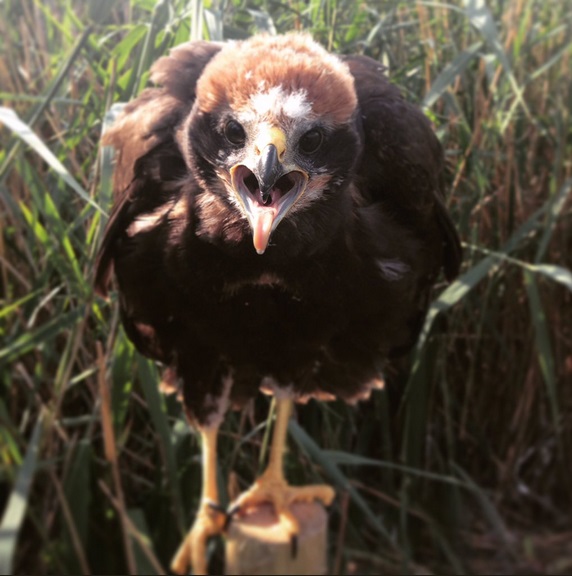Site menu:
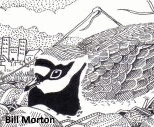
August 2018 Newsletter
Species Spotlight - Little Ringed Plover.
Review - Scarce and Rare Birds in North Wales.
Colour Ring Report.
July Bird News.
Forthcoming Events.
Latest Newsletter.
Species Spotlight - Little Ringed Plover
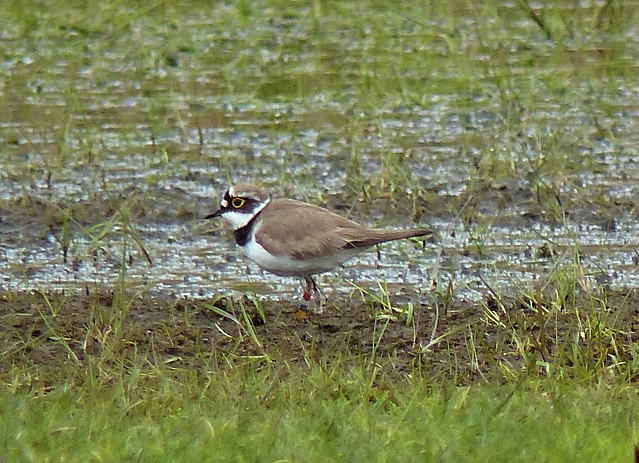
Little Ringed Plover (Charadrius
dubius) is a species which has been rather under the radar
for me. It was when I saw Eddie Williams' photo of a colour-ringed bird
(above) that I realised how little I knew despite writing the Little
Ringed Plover species account for the Cheshire and Wirral Bird Report
for several years! Consequently I've been doing some reading and
compiling some counts over the past few weeks and the result is this
article.
Little Ringed Plover - History and Status
Nobody knows how many Little Ringed Plovers there are. Unlike most waders, which concentrate at certain key sites either on migration or in the winter, they migrate overland on a broad front then spend the winter scattered right across inland Africa south of the Sahara making them virtually impossible to count. Counts are made in some locations of breeding pairs and totals extrapolated from that - so the number of individuals in the European/African population is usually quoted as being between 200,000 and 300,000, obviously with a large margin of error.
During the 20th century this species increased it's range westwards into the UK first breeding in this country in 1938. The westwards movement has continued and they bred in Ireland for the first time in 2008. They prefer to breed on the unvegetated margins of fresh water and they take advantage of gravel pits and sand quarries. There are several of the latter in Cheshire and they first bred here in 1961 after several years of trying through the 1950s. By 1971 they had increased to at least 20 pairs, since then numbers have fluctuated but the average is probably still around 20 pairs. A national survey in 2007 put the total number of pairs breeding in the UK at 1,239, almost double that estimated in the previous survey in 1984 - the highest concentration is in north-west England.
Dee Estuary
The first ever record for the Dee
Estuary was at Shotton Pools in
1958. For a species which is almost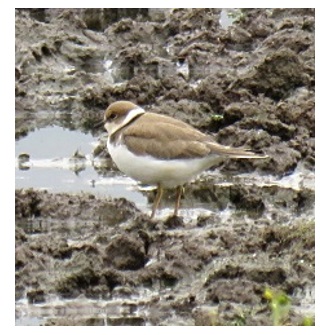 wholly non-maritime they have been
seen surprisingly frequently at Hilbre, first recorded there in 1964
and the following two years - perhaps the same bird was involved. There
have been a further eight records from Hilbre since, nearly always
singles. The first record from Inner Marsh Farm RSPB (now
Burton
Mere
Wetlands)
wasn't until 1991 but since then IMF/BMW has had the vast majority of
records. For example, in 2015, a year which had the highest number of
annual
records for the past 15 years, 94% came from there. 2018 has been no
different with birds ever present at BMW since June 22nd, including a
max count
of six.
wholly non-maritime they have been
seen surprisingly frequently at Hilbre, first recorded there in 1964
and the following two years - perhaps the same bird was involved. There
have been a further eight records from Hilbre since, nearly always
singles. The first record from Inner Marsh Farm RSPB (now
Burton
Mere
Wetlands)
wasn't until 1991 but since then IMF/BMW has had the vast majority of
records. For example, in 2015, a year which had the highest number of
annual
records for the past 15 years, 94% came from there. 2018 has been no
different with birds ever present at BMW since June 22nd, including a
max count
of six.
Photo right - Juvenile Little Ringed Plover at Gilroy Scrape, West Kirby (Richard Smith).
Little Ringed Plovers probably do occasionally breed around the Dee Estuary on sites such as Meols Brick Pit, Shotton and the old Point of Ayr Colliery site, but they are mostly recorded on migration. Just ones and twos are usually seen with the occasional family group, so it is a scarce bird here.
The graph below shows the pattern of migration with the spring peak in the second half of April and the return peaking in July. Two interesting points about this graph, one is the number of records in June when you might expect little or no movement, and the peak in July which is a month earlier than the peak in most of Europe. Birds in June may well include failed breeders and looking at the Cheshire and Wirral and the Lancashire Bird Reports there is quite a high failure rate. In addition many one year old birds don't breed so there may well be be non-breeding birds present. But breeding can finish as early as the second half of June as demonstrated in 2014 when an adult with two well grown young were noted at BMW, having bred elsewhere. The July peak probably means that Burton Mere Wetlands is a staging post for local breeding birds; as well as 20 or so pairs in Cheshire there are usually at least 30 pairs just to the north in Lancashire so it's certainly possible that some pause at Burton Mere Wetlands before flying south to Africa.
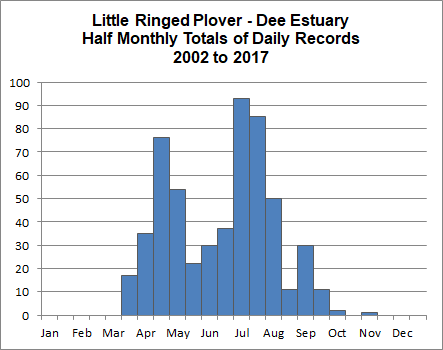
The graph below shows how varied the totals are from year to year, given the small annual numbers involved that really isn't surprising.
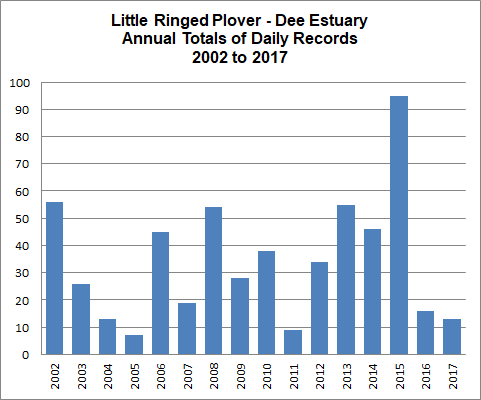
Tracking Little Ringed Plovers
Although relatively few have been ringed, over many years the recoveries tell an interesting story.
The only colour-ringed bird recorded on the Dee Estuary was seen on April 29th 2018 in a wet horse paddock by Leasowe Lighthouse. An interesting record as it was ringed in Angus/Montrose Basin, the most northerly breeding site in the UK, and it was recorded back at it's nesting site on May 7th 2018. Here they breed on shingle along river beds, the natural breeding habitat for this species before they discovered man made gravel beds etc.
Nationally, some birds seem to fly due east or south-east from the UK after breeding and there have been a total of seven ring recoveries in Belgium and Germany, it is possible these birds then fly to the east side of Africa or maybe even the middle-east, as some European birds do, but there have been no recoveries of UK birds from there.
There have been several recoveries from the Camargue in southern France suggesting that this site is an important staging post. Some birds fly due south as there have been seven recoveries from Portugal and Spain, and three across the Mediterranean in Morocco, Melilla and Tunisia. In their wintering range there have been just three recoveries of UK ringed birds, all in West Africa south of the Sahara, in Burkina, Mali and Togo.
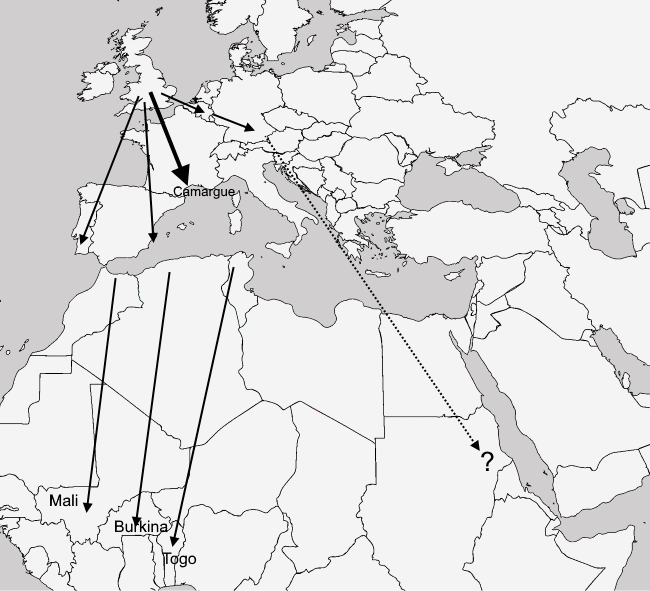
The information gleaned from ringing recoveries (including colour-ringed birds) is fascinating but it is somewhat limited, for example we know virtually nothing about exact migration routes, speed of migration or what birds do when they reach the wintering areas. The recent development of light-weight geolocators is changing all that. Some work has already been done with Little Ringed Plovers which breed in southern Sweden and I finish this article by quoting from Ref 8 and I also reproduce Figure 1 from that paper:
Our results from using geolocators to track migration in a local population of Little Ringed Plovers revealed an enormous spread of wintering sites, ranging from West Africa to India. The migration strategy mainly consisted of relatively short flights with multiple stopovers unlike many other shore-birds that, instead, make one or a few long flights. Four out of six birds divided the autumn migration into two phases, with a rather long period of residency at a site in the Middle East. Therefore, the timing of arrival to the final wintering site differed quite a lot between individuals.
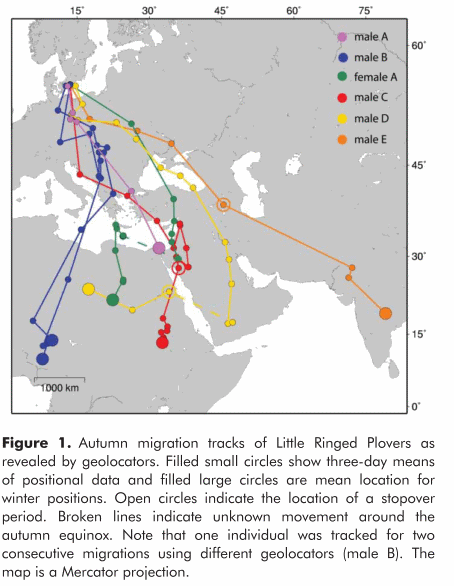
References
1. Waterbird Population Estimates, Fifth Edition, Wetlands International 2012.2. T. Hedley Bell, The Birds of Cheshire, Sherratt, 1962 and Supplement 1967.
3. Records sent to Richard Smith and published in deeestuary.co.uk (2002 to 2018).
4. Cheshire and Wirral Bird Reports from 1964 (CAWOS).
5. BTO Bird Atlas 2007-11, 2013.
6. BTO Migration Atlas, Poyser, 2002.
7. BTO on-line ringing information available on https://www.bto.org/volunteer-surveys/ringing.
8. Anders Hedenström, Raymond H.G. Klaassen & Susanne Åkesson (2013), Migration of the Little Ringed Plover Charadrius dubius breeding in South Sweden tracked by geolocators, Bird Study, 60:4, 466-474.
Richard Smith.
Review - Scarce and Rare Birds in North Wales
This makes a great companion book to 'Rare and Scarce Birds of Cheshire & Wirral' reviewed in the November 2017 Newsletter. It covers a large area, five vice counties, and a huge amount of work has gone into writing this fascinating book. There are many different sections but the highlights for me are the article by Ken Croft 'The Birding Year in North Wales', a very detailed Systematic List of Records and no less than 19 finder's articles ranging from the Cretzschmar's Bunting' in 2015 to a 'Summer Tanager' all the way back in 1957. Both those species were seen on Bardsey Island and, remarkably, that small island contributes 47% of all records in the book, as nicely illustrated in a pie chart on page 26.
I finish with a short extract from Ken 'mega-magnet' Croft's article:
August: A month when our thoughts turn to waders and a good place to visit would be the Dee Estuary, you never know what might be lurking out there in the vastness? Birds are drawn in and filtered along the coast especially on the spring tides. Here are some of the August birds found on the Dee: Pacific Golden Plover, Baird's Sandpiper, Buff-breasted Sandpiper, Long-billed Dowitcher and Wilson's Phalarope. It is also the start of the autumn migration of passerines and maybe it is a time to think of a visit to Bardsey? A few rare warblers may be skulking out there on the island: Aquatic, Savi's, Booted, Bonelli's, Greenish as well as Melodious, Icterine and Barred Warbler have all been found on Bardsey in August as well as Britain's first record of Yellow Warbler in 1964. Finally, if we are going to see Cory's Shearwater, and we don't see many in North Wales, this is the best month to look for one. Point Lynas, Bardsey or The Range all likely vantages in optimal weather conditions.
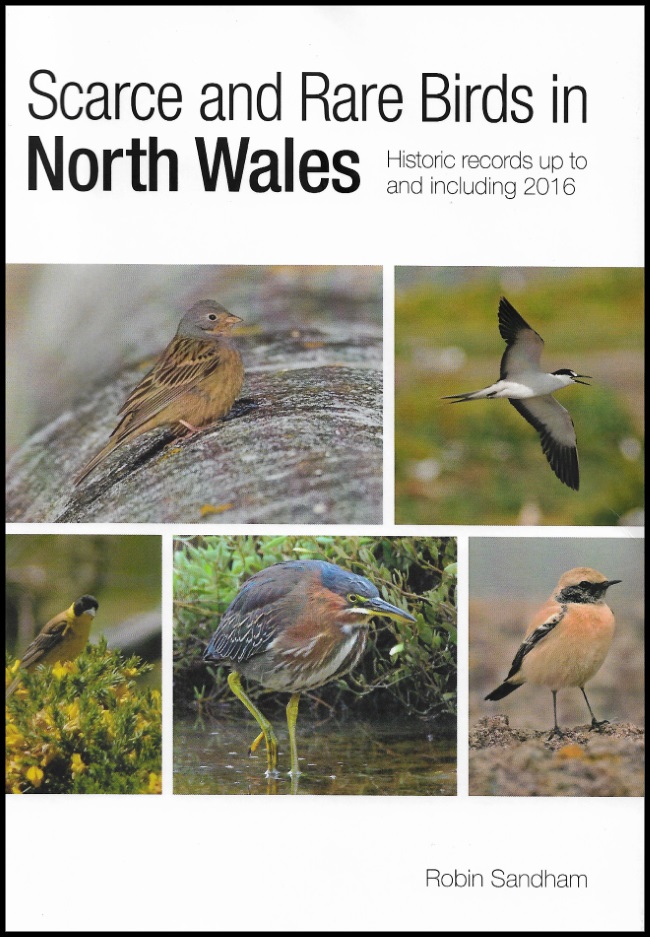 This book is
obtainable at https://www.nhbs.com/,
at Conwy RSPB or directly from the author, Robin Sandham - robinsandham@hotmail.co.uk.
This book is
obtainable at https://www.nhbs.com/,
at Conwy RSPB or directly from the author, Robin Sandham - robinsandham@hotmail.co.uk.
Top of Page
Colour Ring Report
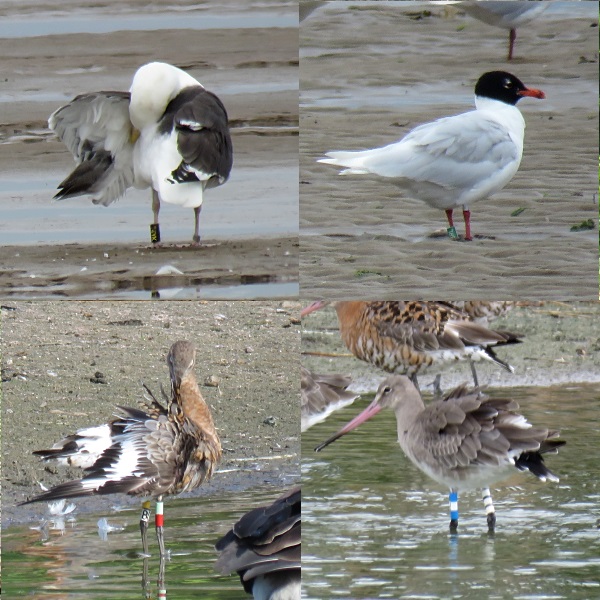
Black-tailed Godwit BWB-W=, Black-tailed Godwit Y8-LR (all photos Richard Smith).
A good month for colour-ringed birds with several gulls, Sandwich Terns, Little Terns and black-tailed Godwits recorded. Here is a selection:
Great Black-backed Gull
T4YK
- yellow letters on black ring (left tarsus).
Ringed on Calf of Man, Isle of Man, on June 24th 2014, as a
chick.
Recorded on Hoylake shore on July 16th 2018.
The only other record for this bird was in July 2016, also on Hoylake
shore, so we don't know where it is breeding.
Mediterranean Gull
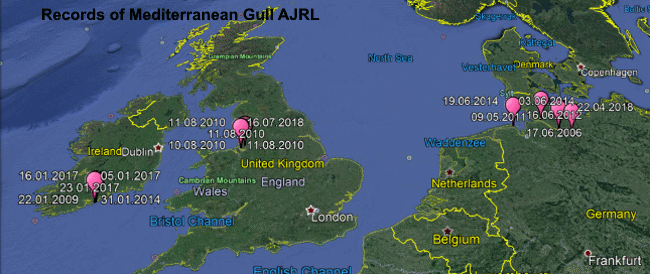
AJRL - white letters on green ring (left tarsus).
Ringed in Niedersachen (Lower Saxony), northern Germany, on June 17th 2006 as a chick.
Recorded on Hoylake Shore on July 16th 2018.
The map, above, illustrates the movements of this bird which has been recorded 26 times since it was ringed. It spends mid-winter in Cork Harbour and has been recorded breeding back in Germany most springs, including 2018. This bird has been seen on Hoylake shore on August 2010 and July 2018, presumably on the way to spend winter in Ireland. There it is joined by many others of it species with typical counts at Sandymount Strand, Dublin, now well over 100 in July, and many more in Cork Harbour. Perhaps the majority of the Mediterranean Gulls we see here from June to August end up in Ireland.
Black-tailed Godwits
BWB-W=Ringed at Harper's Island, Cork Harbour, Ireland on May 8th 2018, this bird was a juvenile in 2017 so now one year old.
Recorded at Caldy Wildfowl Collection on July 1st 2018 and present all month. No other records.
There is a new Wetland Centre at Harper's Island where this bird was ringed, looks well worth a visit if you are in southern Ireland.
See www.birdwatchcork.com/harper's.htm and www.facebook.com/harpersislandwetland/.
We saw several other colour-ringed Black-tailed Godwits at Caldy in July and it's very much a story of the return of the regulars, including:
L//L-L - first seen on the Dee estuary in September 2005 and a total of 204 times since.
WR-WX - first seen on the Dee estuary in November 2011 and a total of 786 times since.
Y8-LR - first seen on the Dee estuary in September 2013 and a total of 128 times since.
WW-OYflag - first seen on the Dee estuary in October 2013 and a total of 165 times since.
WO-WRflag - first seen on the Dee estuary in July 2014 and a total of 185 times since.
Little Terns
Good numbers of colour-ringed Little Terns have been recorded at Gronant over the past month including many re-sightings of ones ringed there plus others ringed at the Isle of Man. Also a few from NE of England, including:DW on blue ring. Ringed at Crimdon Dene, County Durham, in 2016 as a chick.
Recorded at Gronant in August 2017 and in July 2018.
This (and other sightings) confirms that some one and two year old birds do return to the UK, previously it had been thought one year old birds and a lot of two year old birds stay off West Africa in the summer. These young birds are presumably travelling with the adults but it's interesting that some end up a long way from the colony where they hatched.
Sandwich Terns
Five juvenile Sandwich Terns were recorded at Gronant in July, four on 23rd and one on 24th.Two were ringed as chicks at Hodbarrow, Cumbria, on June 26th 2018.
Three were ringed at Lady's Island Lake, Wexford, Ireland, between June 17th and 29th 2018.
This dispersal of both young and adult Sandwich Terns to the Dee estuary area happens every year with the Dee estuary being one of the most important migration staging posts in the country for this species.
Richard Smith. Colour-rings were also recorded by Tim Kinch, Steve Hinde and Henry Cook.
Top of PageJuly Bird News
The exciting news of the month was the announcement by the RSPB that a
pair of Marsh Harriers bred and successfully reared three chicks in
Neston Reed Bed, a first for the Dee Estuary.
Mediterranean Gulls were much in evidence and Heswall shore had five adults on the 10th with several recorded along north Wirral, West Kirby and Gronant. Numbers of Sandwich Terns increased in numbers through the month, the highest count being 746 at Hilbre on the 31st. A flat calm sea on the 30th resulted in a sighting of a Storm Petrel off Hilbre, and on the same day 6,500 Herring Gulls were on West Hoyle Bank.
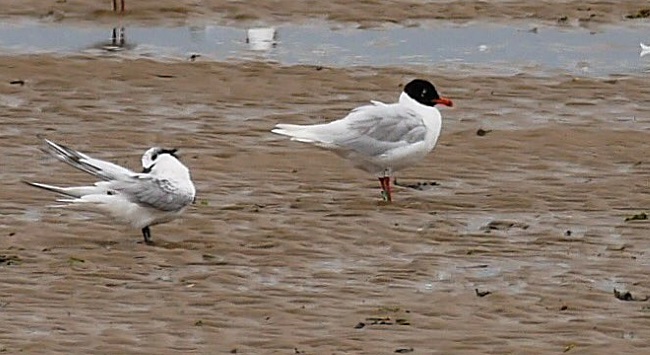
The month started with 490 Black-tailed Godwits at Caldy, these were
mainly non-breeding birds spending the summer here, but numbers quickly
increased with adults arriving from Iceland so that by the month-end we
had a remarkable 2,840, a record high July count for the estuary. They
say they had a poor breeding season but that remains to be seen, the
early arrival of the first juvenile on the 29th bodes well.
Little Ringed Plovers have been ever present at Burton Mere Wetlands
and we had an adult Curlew Sandpiper there at the end of the month. A
Spotted Crake was an excellent record at Burton Mere Wetlands on the
25th.
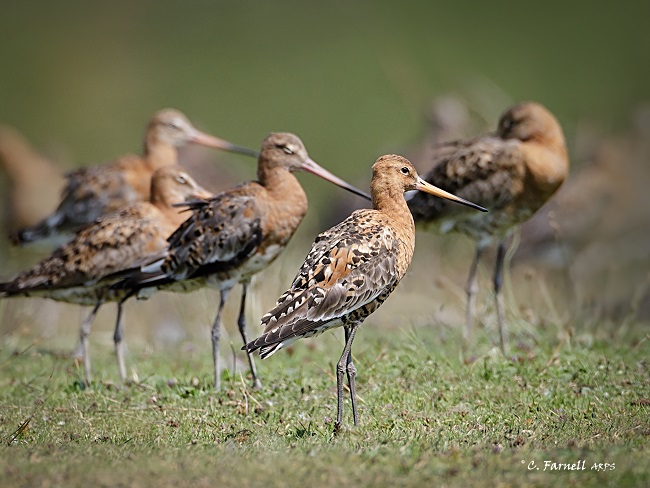
10 Goosanders, perhaps a single brood, were an unexpected sight at Burton Mere Wetlands on the 8th, with one at Hilbre a few days later. Summer records of Goosanders on the estuary and off north Wirral are actually fairly regular with birds dispersing away from their breeding grounds. Eiders were present all winter off Hilbre and now at least one has been there most of the summer with a good count of 14 on the 25th.
The Little Tern breeding season at
Gronant has effectively been split
into two. There were 80 fledged from the nests which survived storm
Hector, and there are now 190 newly hatched chicks from those pairs
which re-laid after their nests were washed away. We don't know how
many of these will fledge, and there has been quite a lot of predation
from Kestrels, Peregrines, etc. but it is still looking like it's going
to be a good season. The 'third wave' arrived in July giving a total of
620 Little Terns, this increase in numbers occurs every year and is
thought to be mainly adult birds from other colonies, either failed or
early breeders, but an influx of non-breeding immature birds is also
possible.
Perhaps the strangest sight of the month was the over-night roosting of up to 230 Swallows on the rocks at Niffy Bay, Hilbre, then suddenly erupting at first light. There are no records of them roosting there before, they normally roost in reed beds and indeed 1,000 did so in Neston Reed Bed during July.
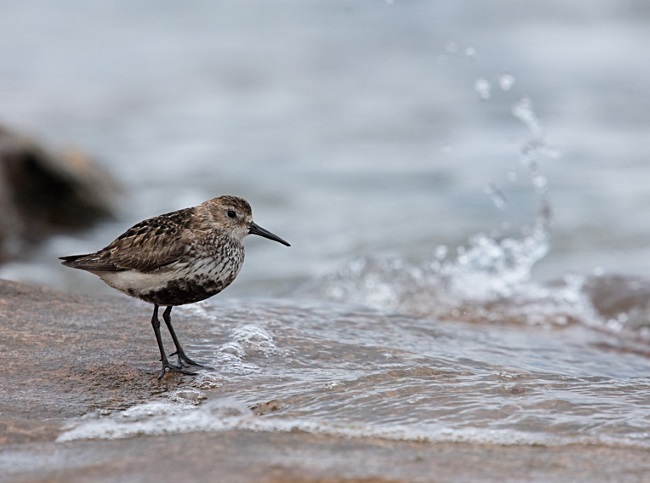
Many thanks go to Jeremy Bradshaw, Jason King, Mark Woodhead, Graham Connolly, Richard Steel, Charles Farnell, David Haigh, Steve Hinde, Mark Turner, Stephen Simpson, Malcolm Neal, Richard Payne, Neil Mcmorran, Matt Thomas, Chris Butterworth, David Leeming, Alan Hitchmough, Steve Williams, Dave Edwards, Derek Bates, Allan Conlin, Karen Leeming, Frank Burns, David Thompson, Henry Cook, Jeff Cohen, Graham Jones, Graham Thompson, Richard Beckett, Ron Armstrong, David Small, Steve Jennings, Geoff Robinson, Ian Hutton, Pete Riley, Hugh Stewart, the Lighthouse and Wirral Birding Blog, the Dee Estuary Wardens and the Hilbre Bird Observatory for their sightings during July. All sightings are gratefully received.
Top of Page
What to expect in August
A very busy month but difficult to predict as each August is different. But there will be plenty of terns around, most years we get a few Black Terns passing through with Hilbre, Red Rocks and Hoylake favoured spots. Numbers of Sandwich Terns will remain high, probably at least 3,000 for the whole estuary, and as the Common and Little Tern breeding season finishes these will pour into the estuary. Out to sea we should get both Arctic and Great Skuas harassing the gulls and terns and, given a strong westerly, Storm Petrels may be blown towards the coast, together with Gannets and Manx Shearwaters. At the end of the month any north-west gales should result in the sighting of an early Leach's Petrel.
August is also all about waders and we can get a large passage of Dunlins and Ringed Plovers best seen at Hoylake and Gronant. Further into the estuary, and at fresh water sites, we can get good numbers of Spotted Redshanks, Ruffs and Greenshanks, and by the end of the month juvenile Curlew Sandpipers should start coming through with Hoylake usually the best place to see these. Black-tailed Godwits will continue to increase at Caldy and we could get as many as 4,000 which will include this year's crop of juveniles. Ken Croft, above, has mentioned some of the rare waders we have seen in previous Augusts, to add to his list is a Lesser Yellowlegs at Burton Mere Wetlands a few years ago.
On the marshes expect Great Egrets and Marsh Harriers to reach double figures and one or two Hen Harriers will have returned, also perhaps Short-eared Owls. On southwards migration will also be smaller birds such as Wheatear and Willow Warblers and some years we can get quite large 'falls' of these.
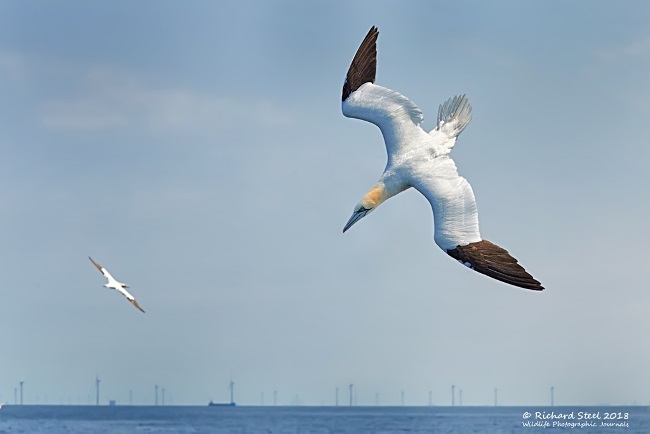
http://wildlifephotographic.blogspot.com/
Top of Page
Forthcoming Events
August Highest Spring Tides (Liverpool)
Also see Tides page.
12th August, 12.36hrs (BST),
9.8m.
13th August, 13.23hrs (BST), 9.8m.
14th August, 14.08hrs (BST), 9.7m.
Forthcoming Events
Organised by the Wirral Ranger Service , Flintshire Countryside Service and the RSPB (Dee Estuary): All these events and walks have bird interest, even those not advertised specifically for birdwatching. No need to book for these events unless specified - please check below.
Saturday 11th August - Hoylake High Tide Birdwatch with RSPB Liverpool Local Group.
10am start, high tide at 11.35am, 9.5m.
At this time of year the beach should be full of Dunlin and Ringed Plover and the noise of Sandwich Terns will be everywhere plus good numbers of Common Terns. There is also a good chance of seeing Arctic, Little and Black Terns. There will be a large gull roost which can include Mediterranean Gull sand Yellow-legged Gulls. Out to sea we can expect Gannets and skuas, given a strong westerly Manx Shearwaters will be flying past.
Sunday 12 August - Hen Harrier Day at Parkgate.
12pm to 3pm at Old Baths Car Park, Parkgate.
Guest Speakers include Iolo Williams, James Bray, Findlay Wilde and Mark Avery.
Click here to Download Poster.
Sunday 19th August - 'Liverbird' Birdwatching and Nature Discovery Cruise.
Mersey Ferries and the RSPB are hosting a 'Liverbird' Bird Watching & Nature Discovery Cruise on the River Mersey and out into the bay, on Sunday 19th August. The cruise is perfect for families and both new and experienced watchers. Sightings have previously included long-tailed skuas, peregrine falcons, osprey and Atlantic grey seals. Experts will be on-hand to answer your questions and help with the spotting of wildlife. Booking Essential. Buy tickets on-line:
https://www.merseyferries.co.uk/cruises/special-cruises-and-events/Pages/
Wildlife-and-Nature-Discovery-Cruise.aspx
Saturday 25th August - Hilbre High Tide Birdwatch.
8.30am-3.30pm.
Price: £10 per person.
Booking essential. Contact: westkirbyhoylakemeolsparks@wirral.gov.uk
Join the Coastal Rangers and the RSPB for this exclusive chance to walk across the sands to Hilbre Island, and remain there over high tide to enjoy the island's birds and wildlife.
The walk lasts up to 7 hours and all attendees must stay on the island until it is safe to return as the tide recedes. Bring some lunch and wear suitable clothing, stout footwear or wellingtons are recommended. Bring binoculars if you have them. Composting toilets are available on the island.
Places are limited and there is a charge of £10 per person which will be shared between the RSPB and Friends of Hilbre.
Meet by noticeboard at West Kirby Sailing School car park at the north end of the marine lake.
Saturday 15th September - Hilbre Low Tide Birdwatch.
9am-1pm.
Price: £7 per person.
Booking essential. Contact: westkirbyhoylakemeolsparks@wirral.gov.uk
Join the Coastal Rangers and the RSPB on this low tide walk across the sands to Hilbre Island to look for the special birds that return here for the winter months, and others that use it as a vital rest stop on their autumn migration. Suitable clothing, stout footwear or wellingtons are recommended. Bring binoculars if you have them.
The walk lasts approximately 3.5-4 hours and covers around 4 miles across fairly soft, flat ground and some seaweed covered rocks. Composting toilets are available on the island.
Places are limited and there is a charge of £7 per person which will be shared between the RSPB and Friends of Hilbre.
Meet by noticeboard at West Kirby Sailing School car park at the north end of the marine lake.
Saturday 27th and Sunday 28th October - WIRRAL WADER FESTIVAL
Advance notice of this annual event - see http://wirralwaderfestival.blogspot.com/p/2018.html for more details.
There will be high tide roost watching events at both Hoylake and Red Rocks/West Kirby.
There will also be an indoor event at the Hoylake Sailing Club on Hoylake seafront, where stalls and children's activities can be found.
More details to follow.
